High Performance X-tal filter using surplus X-tals
Crystal filters for 50 kHz channel separation FM radios have a bandwidth of 30 kHz. These filters are usually built from conventional crystals contrary to more modern filters which are built from more complex quartz resonators. More modern filters are smaller and they are usually designed for smaller channel separation. Filters like the ones in fig. 1 contain 8 useful crystals each.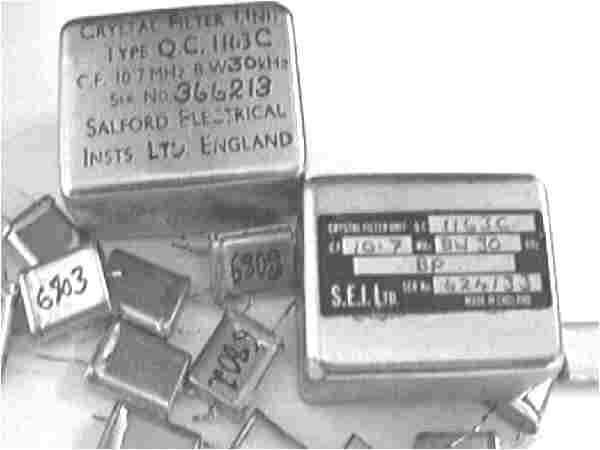
Fig 1. Old-fashioned 10.7 MHz filters for 50 kHZ channel separation. These filters contain very useful crystals like those shown in the figure.
To obtain a bandwidth of 30 kHZ a typical filter is designed like in fig 2. Two identical filter sections are connected back to back, so the total number of crystals in each filter is 8. Typically X1 and X2 form a pair with 16 kHz separation. X3 and X4 form another pair with 24 kHz frequency separation. There are two X1,X2 pairs and two X3,X4 pairs in each filter.
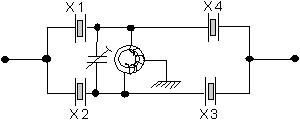
Fig 2. Basic filter section for filters like those shown in fig. 1 Each filter contains two of these sections back to back so there are two crystals at each frequency in one filter unit.
By connecting the components from a 30 kHz filter differently as shown in fig 3 one can get a filter shape that fits very well to the 22 kHz bandwidth of the Soundblaster.
The two crystals X1,X2 have their resonance's separated by 16 kHz. Typically they are at 10.684 and 10.700 MHz. X3 and X4 have their resonance's 4 kHz further out, and they produce notches because they are series resonance's to ground. It does not matter which side X3 and X4 are connected to. They can even be connected to the same side. The important thing is that they short circuit one of the windings on the toroid transformer at the series resonance frequency. The two windings are so well coupled so it does not matter which of them is shorted. Likewise it is possible to connect the tuning capacitor between one side and ground instead of between the two sides. The impedance at either end of the transformer is low at the resonance frequency of X1 and X2. The notch frequencies X3 and X4 are rather close, so the notches are not very deep, only about 35 dB - but they are very sharp. The crystals X3 and X4 do not only produce the notches, they also produce resonances halfway between the frequencies for X1,X2 and X3,X4 that make the flat region wider and greatly improve the shape factor of the filter.
Like always, the filter has to be terminated in correct impedances at both ends, so to obtain the response of fig 4, there are two parallel LC cirquits, one at each end of the filter. An adjustable resistor, set to about 2 kiloohms is connected parallel to L and C so the filter looks into approximately 2 kiloohms resistive impedance in both directions. The total number of tunable components is 5. The frequency response is easily made flatter than shown in fig 4, but the particular shape shown is the one that fits to the total filter chain, making the total response flat.
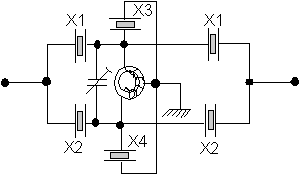
Fig 3. Using six of the eight crystals from a 30kHz wide filter connected like this produces a 20kHz filter with very steep skirts. For frequency response see fig 4.
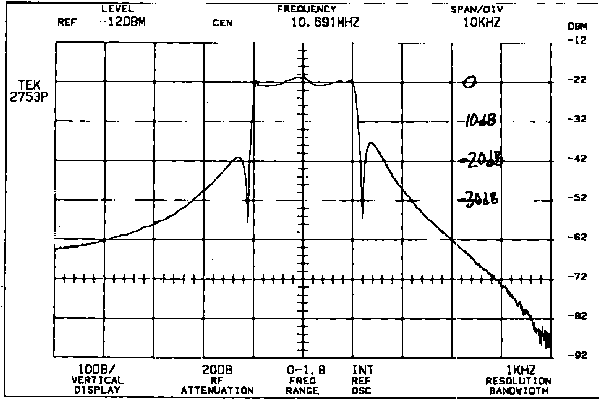
Fig 4. Frequency response of filter using 6 crystals. (see fig 3) Note that a tuneable LC cirquit with a variable resistor is connected at each end of the filter to obtain the frequency response shown. Note also that the filter can be tuned to be nearly flat in case it would be desireable.
Moving the notches outwards
The filter section that one would like to add to the one shown above is a similar filter, but with the notches moved slightly further out. The resonances are moved by connecting an inductor or a capacitor in series with the crystal. When the notch frequency is shifted further out, one can connect the notch crystals across both windings of the toroid to make the notches deeper. Two extra pairs of X3,X4 crystals are added at the input and output to make the inner notches deeper. These additional X3,X4 pairs are added at a point with rather low impedance, so they affect the response only very near their respective resonance. The diagram of the second filter section is shown in fig 5, and the frequency response of the first and the second filter sections together is shown in fig. 6. Like the first section the second section has a parallel RLC circuit at each end. The second section needs about 1 kiloohm resistive impedance at both ends to give the correct frequency response.
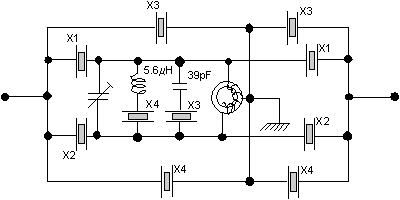
Fig 5. Modified filter section with notches moved outwards as compared to the filter section in fig 2. Two X3,X4 pairs are added to make the inner notches deeper. For frequency response of this filter in series with the filter section shown in fig 2, see fig 6.
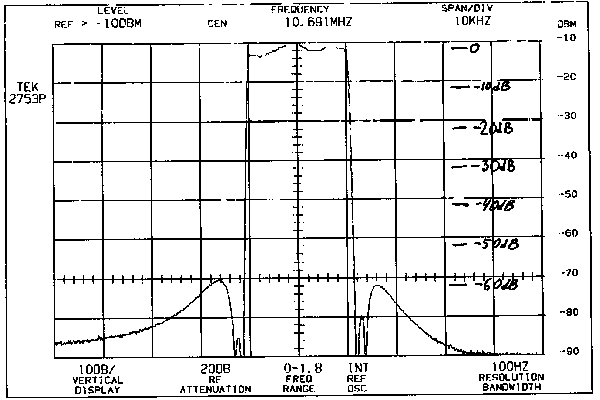
Fig 6. Frequency response of first and second filter sections together. (fig. 3 and fig. 5 together)
There is a buffer amplifier between the sections, and in total four tuneable LC cirquits with a variable resistor across, one at each end of each filter section. Buffers and matching LCR circuits are not shown in the diagrams.
Adding more notches further out
As can be seen from fig 6, the stop band attenuation required can be obtained by connecting in series two filter sections of each type. Rather than making more of the filter sections described above it is of course more efficient to to add new filter sections with their notches even further out. The schematic diagram is shown in fig 7. By use of higher reactive impedances in series with the crystals (larger L and smaller C) one can move the notches further out. The third filter is also terminated in a tunable RLC network at each end to make the filter see about 800 ohms resistive impedance.

Fig 7. Further modified filter section with notches moved outwards as compared to the filter section in fig 5.
It may be a good idea to start by balancing the parasitic capacitance of the crystal with an inductor when pulling the frequency far away. This is a general rule, good to know in design of VXO's and whenever one wants to tune the frequency of a crystal using the series resonance frequency. A parallell inductor removes the parallel resonance of the crystal and makes it behave as a pure series resonant circuit over a reasonably large range of frequencies. Fig 7 shows the transmission through a crystal in a 50 ohm system with and without a parallel inductor.
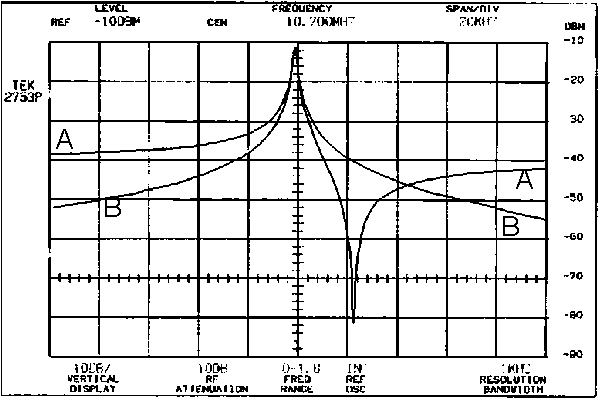
Fig 8. The frequency response when a crystal is connected in series in a 50 ohm system. The A curve is the crystal only, and the B curve is the crystal in parallel with an inductor. 56 microhenry in this case.
If the BFO is placed below the lower edge of the filter, the audio frequencies come in the same order as the signal frequencies. Not that such a thing matters - it would be easy to reverse the order in software. The audio may be used for other purposes, and keeping the frequencies in the right order may eliminate some confusion. There is however another aspect of placing the BFO below the filter passband. The last link in the filter chain, using just a single crystal connected as in fig. 9 gives a notch that is placed at the centre of the image frequency region, and it gives a peak of rather low Q that can be tuned across the pass band and compensate for any slope that may be present due to the combined response of the three more complex filter sections.
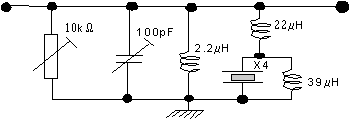
Fig 9. Simple notch filter that provides an adjustable slope within the passband.
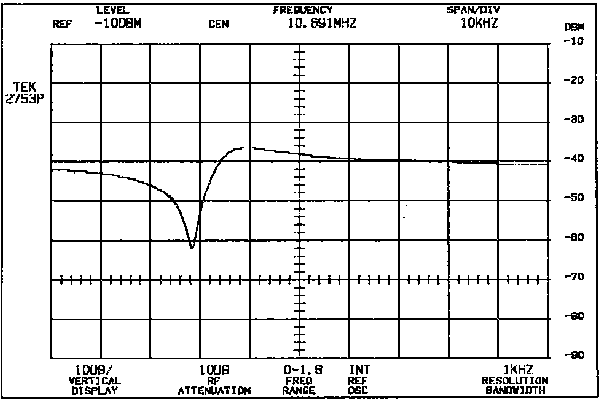
Fig 10. The frequency response of the single crystal notch and slope adjustment filter of fig 9. Note that the peak can be moved from well outside the lower frequency to well outside the upper frequency of the passband with the tuning capacitor. The notch is unaffected by the tuning. The resistor value 10 kilo ohm is the combined resistive part of source, load and the adjustable resistor. Likewise, the trimmer capacitor value is the combined capacitance of the source, load and trimmer. Tuning the capacitance moves the peak in frequency, changing R changes the Q of the peak. The shape of the notch is independent of the tuning.
Frequency response for complete unit
The total frequency response for all filter sections is shown in fig 11 and fig 12. The stop band attenuation is more than 100 dB for all mirror image frequencies and the passband ripple is close to +/- 0.5 dB. Both channels of the stereo system are very similar. Fig 11 is probably inaccurate at levels below -120 dB due inadequate screening of the probe picking up the IF signal on the second mixer input.

Fig 11. Frequency response of the complete IF chain as described above. This curve shows skirt steepness and stop band rejection.
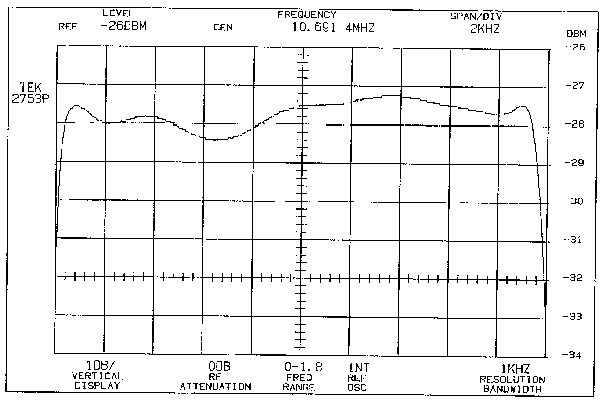
Fig 12. Frequency response of the complete IF chain as described above. This curve shows passband ripple, Y axis is 1 dB per division. The 3 dB points are separated by 19.9 kHz.
Practical design and tuning
When building some equipment that is not intended to be put into serial production, it is very convenient to use double sided epoxy laminate that is soldered together to form boxes of suitable size. It is a very good idea to make the boxes rather large - that automatically gives some distance between different functions and reduces the need for screening walls.The box that contains the IF filter described above, including buffer amplifiers and the second mixer is shown in the photograph in fig 13. The box is about 10 x 33 x 4 cm and it contains two complete IF and second mixer chains for a stereo system.

Fig 13. The complete IF filter and second mixer unit is rather large, 10 x 33 cm. This photo gives a general idea.
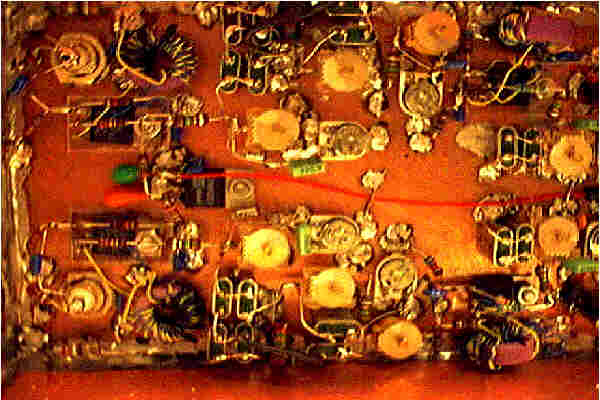
Fig 14. The first section of the IF filter module. The input impedance at the BNC connectors, left corners, is 50 ohms defined by a resistor to ground. High level low noise MOSFET amplifiers with transformer feedback provide power gain and isolation. All units use a 20V supply, but internally the voltage is regulated by local regulators. The MOSFET amplifiers run at 12V from a 7812. The 3 TO220 share a 4 x 10 cm copper sheet on top of the box for cooling. The first filter sections, schematic diagram in fig 3, end just before the two MOSFETS on the right which are the buffer amplifiers isolating the first filter section from the second filter section.
Building and tuning a crystal filters like the ones shown on this site is not as difficult as it may seem. It is certainly not a suitable project for the beginner, and the information on this page is more to inspire experimentation than to serve as a building instruction.
To be successful, make sure to build the amplifier and filter chain step by step and make sure each step works properly before adding the next step. It is a good idea to make sure that all different units have good isolation amplifiers at the inputs and outputs so the filter tuning and system gain does not change when 50 ohm instrumentation is connected instead of the preceding receiver block (first mixer or wideband noise blanker).
All amplifiers should have a large feedback so the total gain of the receiver is very stable. Transformer feedback for low and stable gain with low noise and good linearity is described in many places in the ham literature.
The buffer amplifiers using MOSFETS (BUK551A) have no voltage gain, they amplify by lowering the impedance. The input impedance is defined by a 56 ohm resistor to ground. The low impedance output is connected to the input of the first filter section through an inductor of 1.5 microhenry, and this inductor is tuned by a trimmer and a fixed capacitor to ground from the input of the filter. An adjustable resistor across the trimmer capacitor is used to select the correct input impedance for the filter. In order to not overload the MOSFET the 1.5 microhenry inductor is connected in series with a 3.3 ohm resistor. (The MOSFET looks into a series resonator to ground, and the power gain becomes very large unless the Q of this series circuit is limited) All details are reasonably well visible in the photo, fig 14.
Once the buffers defining the input and output impedance work correctly, start to tune the centre capacitor (the one visible in fig 3). Start with input and output impedances around 1 kiloohm. Look at the signal level at the centre of the passband (right between the series resonance's of X1 and X2) and tune for maximum. Then tune the input and output capacitors for a symmetric filter shape. Finally tune the resistors for a reasonably flat response. Repeat several times, adjusting all 5 points for a flat filter response.
Adjust the different filter sections independently for best flatness first. Once you know how to tune the 5 tuning points, all the filter sections are easy to tune as individual filters.
Finally, connect all filters in series and look at the total filter response. The total response will look a bit ugly, the ripple may be something like 3 or maybe even 6 dB. Now try all the tuning points one by one, but change the setting only of those that really improve the filter flatness. The convergency is good, it is not difficult to get a total flatness below 1 dB.